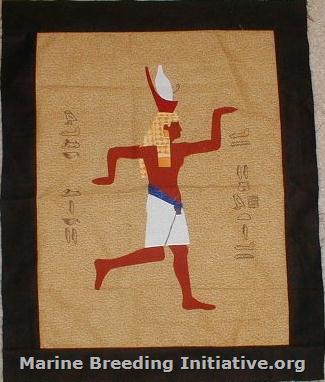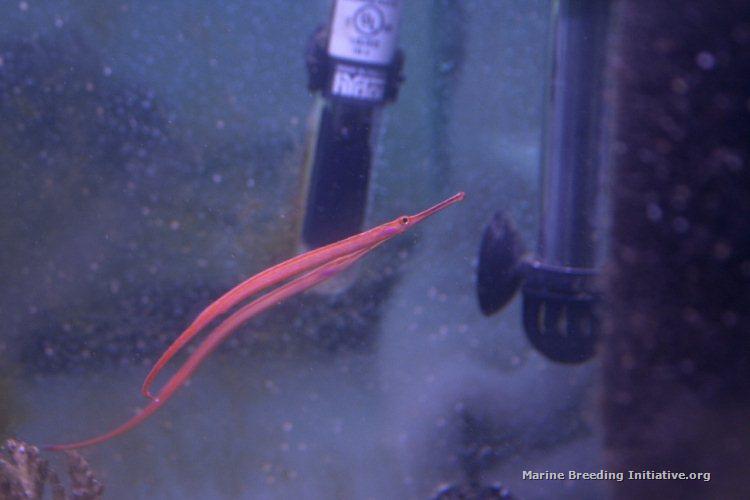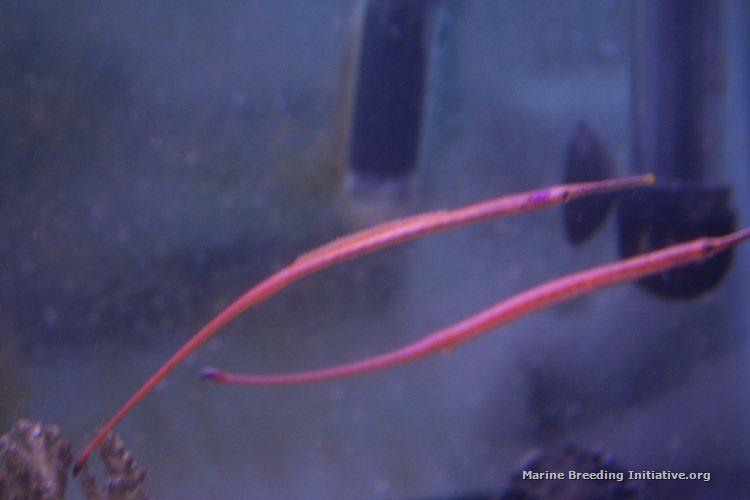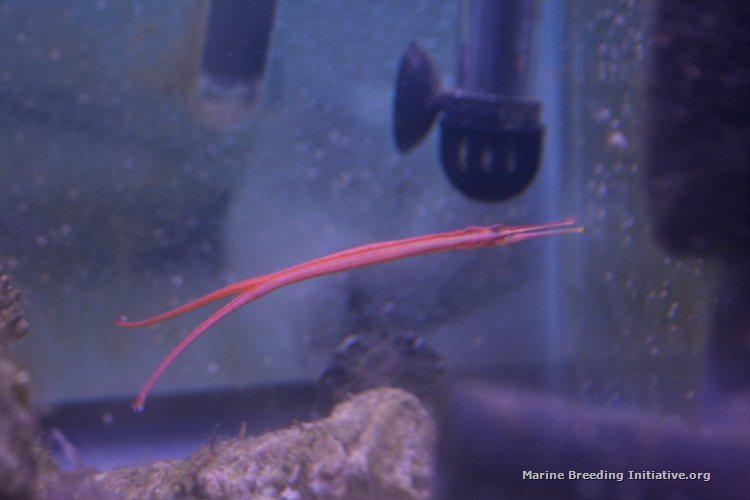Change Page: < 1234567 > | Showing page 4 of 7, messages 61 to 80 of 124 - powered by ASPPlayground.NET Forum Trial Version
Author
|
Message

|
 Re: Breeding Journal, Species: Dunckerocampus baldwini
Thursday, January 17, 2013 11:44 PM
Re: Breeding Journal, Species: Dunckerocampus baldwini
Thursday, January 17, 2013 11:44 PM
( permalink)
FWIW, I've not had much luck with Apocyclops and seahorse fry. I don't know what it is they don't like about them; but they seem to do much better with the Euterpina acutifrons. There were a few times where I let my Euterpina cultures get dangerously low, had a surprise batch of babies, and used the Apocyclops. I had very poor success rate with them; I don't know if it could apply to syngnathids as well. I had the same problem with dragonface pipe larvae ignoring them; though as I only had the one brood I couldn't possibly pin that on the Apocyclops. I have raised clowns on the Apocyclops (just to see if I could). But my luck with them for seahorses has not been great.
My stab-in-the-dark hypothesis is that they have predator avoidance that is quite good. I've seen seahorse fry target them and they manage to zip away over a large distance (a half cm or so) rapidly. I only observed that a couple times though, and it really is just a stab in the dark. It could also be that they multiply so fast that they just are using up the available oxygen and creating a lot of waste, sort of how rotifers can quickly overrun a larvae tank that uses greenwater if you're not careful.
|
|
|
 Re: Breeding Journal, Species: Dunckerocampus baldwini
Saturday, January 19, 2013 8:44 PM
Re: Breeding Journal, Species: Dunckerocampus baldwini
Saturday, January 19, 2013 8:44 PM
( permalink)
Well, the Apocyclops worked for raising the Bluestripe pipefish quite nicely, although I did notice that I got even higher survival rates with Parvocalanus.
It is time for an update. Day by day, the number of fry from this batch has dwindled. A week ago there were 16. The next day, 14. Then 11, 9, 6, and yesterday morning I awoke to only 2 left.
I have noticed that the losses almost always happen during the night. On a hunch, I left the light on the kreisel last night, and I still had two fry this morning. Today is day 11 for these. It may be that they need constant light and constant eating until they get larger. It may also be that I need a different copepod.
I have been able to do a good job of maintaining my Parvocalanus cultures, so far. I should be able to raise the next batch of fry on Parvocalanus alone, at least until they outgrow it.
The male in tank #2 is due to hatch either tomorrow night, or the next night (or both). I'll be keeping a close eye on him, starting tonight, and will be ready with everything I will need to set up a new kreisel for this next batch. The female in tank #2 has been worrying me for the last few days. Last Tuesday night, I put a big ball of chaetomorpha from the sump of the 210 display in their tank, to give them a treat of some live copepods, and both she and the male pigged out on the live stuff. The next morning, I also saw her eagerly eating stuff from the chaetomorpha. Then, about mid-morning, she started just resting kind of listlessly on the bottom of the tank, and really didn't look right. The change was rather abrupt. That was 3 days ago. She's been looking and acting sickly like this the whole time. She is aware when I enter the room, and will move to "hide" from me when I approach the tank. I haven't seen he eating at all the last 3 days, but starting last night, and including today, I have seen her starting to act a bit more normal, doing more normal swimming around, but she still returns to that laying on the bottom behavior. I'm going to treat the tank to a bunch of live Tigriopus tonight, and see if that helps. The male continues to eat well, but does spend a lot of time hanging out near the female.
The pair in Tank #1 spawned again this morning. They are still reluctant eaters, but I've just resigned myself to giving them live things when I have them, and frozen things when I don't. I've had a nice Tigriopus bloom in one of the big buckets in the greenhouse, so I've been able to offer them the copepods rather frequently lately. The male in Tank #1 still is holding himself in this arched posture, and looks rather awkward and/or uncomfortable with this whole egg-holding thing when he is pregnant. Very different from the male in Tank #2, who maintains normal, straight "posture", and doesn't appear to be phased by holding eggs.
|
|
|
 Re: Breeding Journal, Species: Dunckerocampus baldwini
Saturday, January 19, 2013 9:43 PM
Re: Breeding Journal, Species: Dunckerocampus baldwini
Saturday, January 19, 2013 9:43 PM
( permalink)
One observation I, and others have noticed when we have losses at night... Hydroids.
Have you looked for those, or are you pretty sure it is a food intake related issue?
|
|
|
 Re: Breeding Journal, Species: Dunckerocampus baldwini
Saturday, January 19, 2013 9:59 PM
Re: Breeding Journal, Species: Dunckerocampus baldwini
Saturday, January 19, 2013 9:59 PM
( permalink)
There are no hydroids. I am pretty sure it is a food intake issue.
|
|
|
 Re: Breeding Journal, Species: Dunckerocampus baldwini
Tuesday, January 22, 2013 1:54 AM
Re: Breeding Journal, Species: Dunckerocampus baldwini
Tuesday, January 22, 2013 1:54 AM
( permalink)
As of tonight (the end of the 13th day), the two remaining fry from the batch hatched on the evening of January 8th are still alive, and looking healthy. I think the 24 hour photoperiod is working. I added some Moina salina to their kreisel a couple of days ago. There has been an impressive bloom of both Apocyclops and Moina in the last couple of days. I'll probably have to do a substantial water change tomorrow, just to reduce the density of the Apocyclops and the Moina. The female in Tank #2 that had been acting sickly is looking much more normal now. I think she is "out of the woods", as the saying goes. Although the male in Tank #2 was due to have a hatch event last night, there was no hatch. I checked at various times throughout the night, and there were simply no fry. It looks like I'll have to endure another sleepless night tonight. Returning my attention back to the two fry in the kreisel: It appears that they have begun what I would consider "settlement". The main behavioral and/or morphological change that indicates the beginning of settlement with pipefishes, in my experience, is a change in how the "carry" themselves. The "larval" fry tend to carry themselves in a very gentle "S" shape shown very clearly in the image I posted earlier in this topic here: http://www.mbisite.org/Forums/fb.ashx?m=78797 As they begin to settle, they start to hold their tails in a flexed, upright posture that reminds me of a sort of "walk like an Egyptian" hand gesture such as what is shown in this image:  You can also see what I am describing in the second image in this post in my Doryrhamphus excisus journal: http://www.mbisite.org/Forums/fb.ashx?m=60834 You can also see what I am describing on Page 101 of the May/June 2012 Issue of Coral Magazine, in the article, "Successful Breeding of the Yellowbanded Pipefish", in the image with the caption, "Metamorphosing 15-day-old pipefish." You can find the link to the issue here: http://bit.ly/VhcIet In these examples, the fish are holding their tails up, with the flag part still held somewhat horizontal. That's the "Egyptian" posture I'm describing -- it would mimic the upper arms of both arms of the "Egyptian" image, together with the other arm parts of the Egyptian's left arm (to the right in the image). The onset of this posture in the fry, in my experience, coincides with the beginning of metamorphosis/settlement, a more robust condition, a slower, more methodical approach to hunting, and a transition to larger food items. These are all good things. EDIT: By the way, on Page 100 of the May/June 2012 Issue of Coral Magazine the Yellowbanded Pipefish can clearly be seen engaging in the behavior I have previously described as "2 (B)" in my previous post in this topic here: http://www.mbisite.org/Forums/fb.ashx?m=77996 I have determined to my satisfaction that this behavior is courtship behavior in these fish. It can also be seen in the image on Page 50 of the May/June 2011 issue of Coral by Till Deuss about his work breeding Bluestripe Pipefish that you can see here: http://bit.ly/V3rjF2
<message edited by JimWelsh on Saturday, July 20, 2013 12:51 PM>
|
|
|
 Re: Breeding Journal, Species: Dunckerocampus baldwini
Monday, January 28, 2013 5:24 PM
Re: Breeding Journal, Species: Dunckerocampus baldwini
Monday, January 28, 2013 5:24 PM
( permalink)
I am down to just one fry left from the December 30th spawn, but that one is looking nice and strong. I'm going to call that one settled at this point. She (I'm calling this one "She" because I'm hoping it turns out to be a female, so I can pair her up with one of my "spare" males!) is starting to take on some adult coloration. I'll try to get a picture soon. I have added some Tigriopus to her fishbowl, as well as a few Moina, to give her more food variety. She still usually goes after the Apocyclops, and only the smallest Moina are candidates for her to eat, and even those are probably too big, but I still want her to have options. Since my Parvocalanus are doing well, I've been adding some of them, too.
The male in Tank #2 hatched his eggs over a few days, and it was very frustrating trying to snag them. Unlike the other male, and unlike the Bluestripe male, he tends to hatch his eggs shortly before dawn. The few fry that do make it into the snagger have usually been there for a couple of hours by the time I find them, usually because I oversleep, having been up several times during the night looking for fry to hatch.
The female in Tank #2 has gotten over whatever it was that was making her look sickly, but that pair has not spawned, and it has been several days since that male hatched his last eggs.
Meanwhile, the male in Tank #1 is still holding only one or two eggs from the January 19th spawn.
The males in Tank #3 have been fed nothing but frozen foods for over a month now. I see one of them regularly eating the cyclops out of the water column, but the other one still just picks food off the bottom. They both look a little thin, but haven't starved, and are out and about regularly in the tank. The male in Tank #2 also is a very eager eater of frozen cyclops out of the water column. The other three fish, (Female in Tank #2 and both Male and Female in Tank #1) will take frozen, but grudgingly. I'm changing my strategy of trying to force them onto frozen for now. My main concern at this point is to condition them as well as I can. I've been culturing the Tigriopus, and have also ramped up my Moina production, and have resumed hatching Artemia to enrich, so that I can keep them as well fed and healthy as possible. I need more fry to work with, darn it!
|
|
|
 Re: Breeding Journal, Species: Dunckerocampus baldwini
Tuesday, January 29, 2013 11:38 PM
Re: Breeding Journal, Species: Dunckerocampus baldwini
Tuesday, January 29, 2013 11:38 PM
( permalink)
The pair in Tank #1 spawned this morning. Woot! Now, I just need to keep the male well-fed enough so that he carries the eggs to hatch, rather than absorbing them for their nutrition. He's chowing down on 3 day old Artemia enriched for 24 hours with Dan's Feed right now. I've got plenty of Tigriopus and Moina at the ready for him, too.
The lone fry from the December 31 hatch has definitely settled. I gave her a "lights out" night last night, and when I awoke and turned the lights on, she had been sleeping on the bottom of the fishbowl. It scared me at first, as I though maybe she had died, but no, she was just doing a benthic sleeping thing. She is alive and well, and eating nicely tonight.
|
|
|
 Re: Breeding Journal, Species: Dunckerocampus baldwini
Thursday, January 31, 2013 9:31 AM
Re: Breeding Journal, Species: Dunckerocampus baldwini
Thursday, January 31, 2013 9:31 AM
( permalink)
Congratulation! ... but ... we want photos....
--Andy, the bucket man. "Not to know the mandolin is to argue oneself unknown...." --Clara Lanza, 1886
|
|
|
 Re: Breeding Journal, Species: Dunckerocampus baldwini
Friday, February 1, 2013 3:11 AM
Re: Breeding Journal, Species: Dunckerocampus baldwini
Friday, February 1, 2013 3:11 AM
( permalink)
 Originally Posted by Umm_fish?
Congratulation! ... but ... we want photos....
Ya, ya.... It's just that the truth be told, the "greenwater" in the 2 gallon kreisel is quite a murky green. Not very photogenic! I know that I do need to get y'all what I can get you. Photographic evidence of settlement will come soon. The live feed, so far, is working well on the pair in Tank #1. After 3 days now, the male doesn't appear to have absorbed any of his eggs. They have had an average of probably 8 hours or more each day of live food, with constant snicking the whole time during the hours that live food has been available. I think that their snicking muscles must be getting pretty sore! I've been keeping up daily production of Artemia, and growing them out at least 12-24 hours, and often longer, all the while enriching with Dan's Feed, sometimes augmenting with liquid Selco. I've also been having good production of Tigriopus, plus some Moina to feed them. If I can keep Dad well-fed enough, then I look forward to a nice, big hatch from this spawn, and I've also got the Parvocalanus ramped up nicely, and ready for the expected hatch in about a week now.
|
|
|
 Re: Breeding Journal, Species: Dunckerocampus baldwini
Friday, February 1, 2013 9:14 AM
Re: Breeding Journal, Species: Dunckerocampus baldwini
Friday, February 1, 2013 9:14 AM
( permalink)
It wasn't so much, "I want evidence!" so much as, "I want to see cute pipefish babies!" 
--Andy, the bucket man. "Not to know the mandolin is to argue oneself unknown...." --Clara Lanza, 1886
|
|
|
 Re: Breeding Journal, Species: Dunckerocampus baldwini
Saturday, February 2, 2013 1:33 AM
Re: Breeding Journal, Species: Dunckerocampus baldwini
Saturday, February 2, 2013 1:33 AM
( permalink)
|
|
|
 Re: Breeding Journal, Species: Dunckerocampus baldwini
Saturday, February 2, 2013 1:36 AM
Re: Breeding Journal, Species: Dunckerocampus baldwini
Saturday, February 2, 2013 1:36 AM
( permalink)
WOOT!!!!!!!!!!!!!!!!!!!!!!!!!!!!!!!!!!!!!!
|
|
|
 Re: Breeding Journal, Species: Dunckerocampus baldwini
Saturday, February 2, 2013 11:07 AM
Re: Breeding Journal, Species: Dunckerocampus baldwini
Saturday, February 2, 2013 11:07 AM
( permalink)
She's gorgeous! Thanks for the photos! I totally see the Bangles reference.
--Andy, the bucket man. "Not to know the mandolin is to argue oneself unknown...." --Clara Lanza, 1886
|
|
|
 Re: Breeding Journal, Species: Dunckerocampus baldwini
Saturday, February 2, 2013 12:11 PM
Re: Breeding Journal, Species: Dunckerocampus baldwini
Saturday, February 2, 2013 12:11 PM
( permalink)
very nice.
check out Kathy's Clowns, llc website: http://kathysclowns.com Captive bred clownfish and more (Wholesale to the trade.)
|
|
|
 Re: Breeding Journal, Species: Dunckerocampus baldwini
Saturday, February 2, 2013 11:48 PM
Re: Breeding Journal, Species: Dunckerocampus baldwini
Saturday, February 2, 2013 11:48 PM
( permalink)
Thanks, everybody!
A totally serendipitous feeding thing happened today. For the last several days, I've fed the pair in Tank #1 more or less nothing but live foods, mostly enriched BBS, Tigriopus, and some Moina. Today, I thought, on a hunch, I'd go ahead and feed this tank some of the frozen cyclops in between live food feedings. The female almost immediately started snicking the frozen cyclops right out of the water column, just like the male in Tank #2 and one of the males in Tank #3! I don't know if she has gotten used to eating the larger live Tigriopus from the water column, and the dead cyclops remind her of the Tiggers, or if she somehow has grown weary of the relatively small size of the Artemia, and/or the evasive motion of the live feeds, and has decided to go after the larger, easy-to-catch frozen stuff, or what has finally kicked in to make her "get on board", but whatever it is , I'm STOKED!
For me, this is great news. I now have two males and one female that will eat frozen cyclops eagerly (assuming the female keeps this up in the future). Right now, I don't have any plans on repairing anybody, but if one form or another of breeding disaster were to strike, I'd really like to get a male/female pair of these together that were both eating frozen well, so that I could really fatten them up.
The male in Tank #1 has been enjoying the live feeds, and although he has absorbed or otherwise lost one or two of his eggs, at the end of day 5 post spawn, he is still carrying the vast majority of the eggs from this spawn. I'm still optimistic that I'll get a decent hatch from this spawn.
|
|
|
 Re: Breeding Journal, Species: Dunckerocampus baldwini
Monday, February 4, 2013 11:55 PM
Re: Breeding Journal, Species: Dunckerocampus baldwini
Monday, February 4, 2013 11:55 PM
( permalink)
 Originally Posted by JimWelsh
Here are the cutest pics I could muster tonight:
How old is this one in the photos?
|
|
|
 Re: Breeding Journal, Species: Dunckerocampus baldwini
Tuesday, February 5, 2013 12:17 AM
Re: Breeding Journal, Species: Dunckerocampus baldwini
Tuesday, February 5, 2013 12:17 AM
( permalink)
 Originally Posted by mPedersen
 Originally Posted by JimWelsh
Here are the cutest pics I could muster tonight:
How old is this one in the photos? 24 days.
|
|
|
 Re: Breeding Journal, Species: Dunckerocampus baldwini
Friday, February 8, 2013 1:14 AM
Re: Breeding Journal, Species: Dunckerocampus baldwini
Friday, February 8, 2013 1:14 AM
( permalink)
I had a very small hatch from the pair in Tank #1 last night. It was after 9 days this time instead of 10, probably because I've raised the temperature in that tank up to about 78F about a week ago. The male had once again absorbed most of his eggs by hatch day. I only got about 7 fairly weak fry from this hatch, and as of this evening only 1 is still alive.
I'm calling this a "breeding disaster", in terms of my previous post. The female in Tank #1 continues to eat frozen well, and is looking very fat, healthy, happy, and gravid. Consequently, I have moved the male previously in Tank #1 into Tank #3, and moved the male previously in Tank #3 that is eagerly eating frozen food into Tank #1. Hopefully, they will pair up quickly enough, and this male will be stronger as a result of his better eating habits. Time will tell.
|
|
|
 Re: Breeding Journal, Species: Dunckerocampus baldwini
Friday, February 8, 2013 12:05 PM
Re: Breeding Journal, Species: Dunckerocampus baldwini
Friday, February 8, 2013 12:05 PM
( permalink)
CHAOS!!! MAYHEM!!! Boy, was THAT ever a BAD IDEA!!! As soon as I placed the "Male" from tank #3 into Tank #1 with my "eating female", she started showing major aggression towards "him". If you review my notes earlier in this journal, the only reason that I am assuming the "males" in Tank #3 are males is because they were showing a great deal of aggression towards each other before I moved them into their own tank, and then this aggression died down, presumably because of the absence of any female to fight over. I am now thinking that it is entirely possible that the two fish I've been keeping in Tank #3 are actually two females. I have personally witnessed strong aggression between two female Bluestripe pipefish before, back when I had just acquired two male/female pairs. When there were two pairs, everybody got along just fine in the same tank, but then one of the males died, and the mated female started showing extreme aggression towards the widowed female, who I had to remove for her protection. Ultimately, with the Bluestripes, the mated female eventually died, too, a few months later, and when I placed the lone male in with the "widowed" female, they immediately bonded, and they are my parent broodstock pair to this day. Another possible theory is that these fish are more loyally monogamous than they are generally considered to be, and the pair in Tank #3 really ARE males, but this female is not ready to accept a new, usurping male supplanting her mate so suddenly and quickly. Additional information about this includes the fact that the remaining fish in Tank #3 and the male from Tank #1 I put in there last night seem to get along just fine. In fact, they were doing the bonding "snouts pointing downward" behavior I described as (2)(b) in this post http://www.mbisite.org/Forums/fb.ashx?m=77996 this morning. Ultimately, I don't really know yet the gender of the two fish I've been keeping in Tank #3, but given the new information, I'm leaning towards thinking they are actually two females. At any rate, the aggression being shown to the new introduction in Tank #1 was so great that I decided to move everybody back to their "home" tank this morning, reversing the change I made last night. The male who belongs in Tank #1 was greeted enthusiastically by his female, and they immediately (and I mean IMMEDIATELY) started an egg transfer (which was due to happen this morning)! Here are some pics: In this one, you can see the female's ovipositor. She is the fish on top, and the bump on her lower side is usually not there:  In this blurry (sorry) image, what looks like eggs on the male (top fish swimming upside down) is really just his flaps opened up, as this was taken at the very beginning of the egg transfer, before they had actually transferred any eggs:  And here is a good shot of the actual mating/egg transfer behavior:  They actually get quite acrobatic during this process, at times snaking around each other and doing barrel rolls, and at other times making more of an X shape than an = shape. I guess that for this round, at least, I'll just have to continue to do my best to condition this male as well as possible.
|
|
|
 Re: Breeding Journal, Species: Dunckerocampus baldwini
Friday, February 8, 2013 1:00 PM
Re: Breeding Journal, Species: Dunckerocampus baldwini
Friday, February 8, 2013 1:00 PM
( permalink)
I am certain HD video will be required for the next spawn. The people demand it! 
|
|
|
|